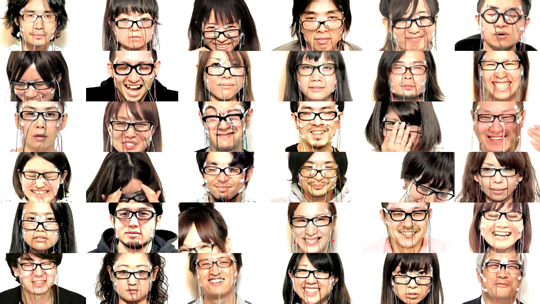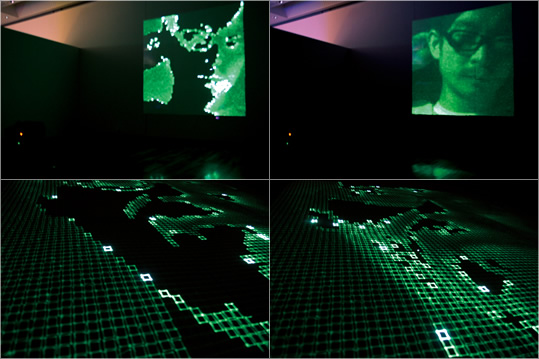![]()
In this exhibition series focusing on the art scene that emerges out of the relationship between media and humans, YCAM has so far introduced a total of ten works and projects by promising young artists. In concert with a special program of the Japan Media Arts Festival, this next installment features Daito Manabe's most representative projects, and in addition, the newest version of an interactive installation by Daito Manabe and Motoi Ishibashi.
scopic measure #11
Daito Manabe "electric stimulus to face" (2008|Video Exhibition)

hown at this event will be a video of Daito Manabe's Face Visualizer, a project "visualizing music"by using myoelectric sensors and electrical stimulation devices to create "expressions"other than the human facial expressions triggered by conscience and feelings. Highly precise myoelectric sensors attached to the face measure the imperceptible flow of electricity that occurs immediately prior to the contraction of a muscle. In this project, human facial expressions are automatically controlled by way of the transmission of electrical signals converted from sounds. In a parallel project,Face Instrument, Manabe translates facial expressions into music and imagery. A video of an experimental performance focusing on the mutual relationship between data and the human body that was staged in 20 cities around the world got 1.6 million views on YouTube.
Performance / Direction / Composition/Sound design and programming: Daito Manabe
Myo-electric sensor, electric stimulation device development: Masaki Teruoka
Hardware development support: Katsuhiko Harada, Tomoaki Yanagisawa
Sound design support: Taeji Sawai, evala
Manipulation support for a performance: Hiroyuki Hori (rhizomatiks)
Production support: rhizomatiks, 4nchor5la6
scopic measure #12
Daito Manabe + Motoi Ishibashi "fade out" (2010|Installation)

The artists developed a device for irradiating a sheet that stores and emits light with an ultraviolet laser, to draw portraits by way of an optical reaction that is completely different from that of video.
The brightness distribution in visitors' photographs shot with an infrared camera is automatically analyzed, according to which the images are then gradually projected onto the sheet on the wall in the reversed order of brightness. The varying shades of light stored on the sheet's surface form recognizable portraits that build up in front of the viewer's eyes. In this newest version that is shown here for the very first time, ultraviolet light is used to add color, whereas the organic "photochromic" compound involved resets the images to their original clear and colorless state as soon as the light irradiation is interrupted.
Produced by: Daito Manabe, rhizomatiks
Concept: Daito Manabe, Motoi Ishibashi
Laser programming: Motoi Ishibashi
Sound programming: Daito Manabe
Cooperation(new version): Aoyama Gakuin University College of Science and Engineering Department of Chemistry and Biological Science Jiro Abe Laboratory, Itoh Optical Industrial Co.,Ltd., KANTO CHEMICAL Co., INC.